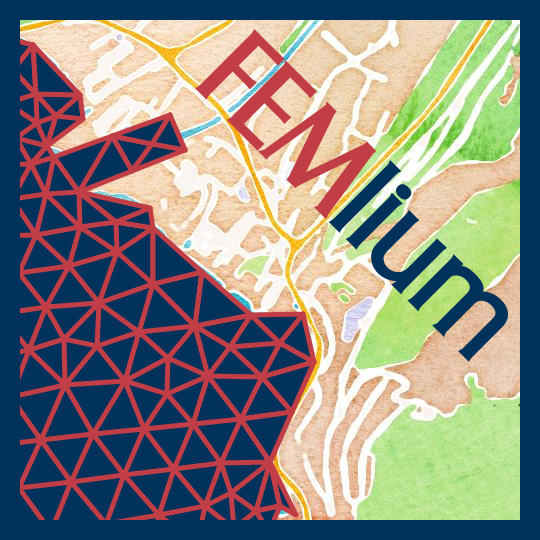

import os
import urllib
import firedrake
import firedrake.pyplot
import folium
import matplotlib.pyplot as plt
import numpy as np
import pyproj
import ufl
import viskex
import femlium
Auxiliary function to get a folium Map close to Lake Garda.
def get_garda_geo_map(boundary_icons: bool = False) -> folium.Map:
"""Get a map close to Lake Garda, and possibly add some boundary markers."""
# Add map close to Lake Garda
geo_map = folium.Map(location=[45.6389113, 10.7521368], zoom_start=10.3)
# Add markers
if boundary_icons:
location_markers = {
"Sarca": [45.87395405, 10.87087005],
"Mincio": [45.43259035, 10.7007715]
}
location_colors = {
"Sarca": "red",
"Mincio": "green"
}
for key in location_markers.keys():
folium.Marker(
location=location_markers[key],
tooltip=key,
icon=folium.Icon(color=location_colors[key])
).add_to(geo_map)
# Return folium map
return geo_map
get_garda_geo_map()
Read the mesh from file with firedrake.
msh_filename = "data/garda.msh"
if not os.path.isfile(msh_filename):
os.makedirs("data", exist_ok=True)
msh_url = (
"https://raw.githubusercontent.com/FEMlium/FEMlium/main/"
"tutorials/01_introduction/data/garda.msh")
with urllib.request.urlopen(msh_url) as response, open(msh_filename, "wb") as msh_file:
msh_file.write(response.read())
mesh = firedrake.Mesh("data/garda.msh")
Plot the mesh using firedrake.pyplot.triplot.
fig = plt.figure(figsize=(12, 12))
firedrake.pyplot.triplot(mesh, axes=fig.gca())
fig.gca().axis("equal")
(np.float64(616658.039149), np.float64(647061.960851), np.float64(5029877.225841), np.float64(5085382.774159))
Plot the mesh and its markers using viskex.
viskex.firedrake.plot_mesh(mesh)
viskex.firedrake.plot_mesh_sets(mesh, 2, "subdomains")
viskex.firedrake.plot_mesh_sets(mesh, 1, "boundaries")
Define a pyproj Transformer to map between different reference systems, because the points read from file are stored a $(x, y)$ pairs in the EPSG32632 reference system, while the map produced by folium is based on (latitude, longitude) pairs in the EPSG4326 reference system.
transformer = pyproj.Transformer.from_crs("epsg:32632", "epsg:4326", always_xy=True)
We define a mesh plotter for meshes in firedrake format, which is implemented in femlium.FiredrakePlotter.
firedrake_plotter = femlium.FiredrakePlotter(transformer)
We use the firedrake_plotter to draw the mesh on top of the geographic map.
geo_map = get_garda_geo_map()
firedrake_plotter.add_mesh_to(geo_map, mesh)
geo_map
We may change the color and the weight of the line.
geo_map = get_garda_geo_map()
firedrake_plotter.add_mesh_to(geo_map, mesh, face_colors="red", face_weights=2)
geo_map
Furthermore, we may set the colors and the weights of the face representation to depend on the markers associated to each segment.
geo_map = get_garda_geo_map(boundary_icons=True)
face_colors = {
0: "gray",
1: "blue",
2: "red",
3: "green"
}
face_weights = {
0: 1,
1: 2,
2: 5,
3: 5
}
firedrake_plotter.add_mesh_to(geo_map, mesh, face_colors=face_colors, face_weights=face_weights)
geo_map
Cells can be colored as well, with a uniform color or depending on the cell markers. We start from a uniform color.
geo_map = get_garda_geo_map()
firedrake_plotter.add_mesh_to(geo_map, mesh, cell_colors="orange")
geo_map
We also show the case of colors being set from cell markers. There are two cell markers in this mesh, equal to 1 for the region close to the shoreline (colored in purple) and 2 for the rest of the domain (colored in yellow).
geo_map = get_garda_geo_map()
cell_colors = {
1: "purple",
2: "yellow"
}
firedrake_plotter.add_mesh_to(geo_map, mesh, cell_colors=cell_colors)
geo_map
Once can use colors associated to both cell and face markers on the same plot.
geo_map = get_garda_geo_map(boundary_icons=True)
firedrake_plotter.add_mesh_to(
geo_map, mesh,
cell_colors=cell_colors, face_colors=face_colors, face_weights=face_weights)
geo_map
In order to define a simple scalar field, we compute the centroid of the domain.
centroid = np.mean(mesh.coordinates.dat.data_ro, axis=0)
We may plot the centroid on top of the mesh.
geo_map = get_garda_geo_map()
firedrake_plotter.add_mesh_to(geo_map, mesh)
folium.Marker(location=transformer.transform(*centroid)[::-1], tooltip="Centroid").add_to(geo_map)
geo_map
The scalar field is defined as $s(\rho, \theta) = \frac{\rho}{\sqrt{1 - 0.5 \cos^2 \theta}}$, and is interpolated on a $\mathbb{P}^2$ finite element space. Here $(\rho, \theta)$ are the polar coordinates centered at the centroid.
scalar_function_space = firedrake.FunctionSpace(mesh, "CG", 2)
x = ufl.SpatialCoordinate(mesh)
rho = ufl.sqrt((x[0] - centroid[0])**2 + (x[1] - centroid[1])**2)
theta = ufl.atan2(x[1] - centroid[1], x[0] - centroid[0])
scalar_field = firedrake.Function(scalar_function_space)
scalar_field.interpolate(rho / ufl.sqrt(1 - 0.5 * ufl.cos(theta)**2))
Coefficient(WithGeometry(FunctionSpace(<firedrake.mesh.MeshTopology object at 0x7efc50daa9f0>, FiniteElement('Lagrange', triangle, 2), name=None), Mesh(VectorElement(FiniteElement('Lagrange', triangle, 1), dim=2), 0)), 3)
We next show a filled contour plot with 15 levels using firedrake.pyplot.tricontourf.
fig = plt.figure(figsize=(12, 12))
trif = firedrake.pyplot.tricontourf(scalar_field, axes=fig.gca(), levels=15, cmap="jet")
fig.colorbar(trif)
fig.gca().axis("equal")
(np.float64(618040.03559), np.float64(645679.96441), np.float64(5032400.20531), np.float64(5082859.79469))
We also show the same plot using viskex.
viskex.firedrake.plot_scalar_field(scalar_field, "scalar")
In order to plot a field on a geographic map, we use again the firedrake_plotter. We may plot the same filled contour plot on the geographic map.
geo_map = get_garda_geo_map()
firedrake_plotter.add_scalar_field_to(geo_map, scalar_field, mode="contourf", levels=15, cmap="jet")
geo_map
Similarly, we can also use (unfilled) contour plots.
fig = plt.figure(figsize=(12, 12))
tri = firedrake.pyplot.tricontour(scalar_field, axes=fig.gca(), levels=15, cmap="jet")
fig.colorbar(tri)
fig.gca().axis("equal")
(np.float64(618040.03559), np.float64(645679.96441), np.float64(5032400.20531), np.float64(5082859.79469))
geo_map = get_garda_geo_map()
firedrake_plotter.add_scalar_field_to(geo_map, scalar_field, mode="contour", levels=15, cmap="jet")
geo_map
One may also combine mesh plots and solution plots.
geo_map = get_garda_geo_map()
firedrake_plotter.add_mesh_to(geo_map, mesh, face_colors="grey")
firedrake_plotter.add_scalar_field_to(geo_map, scalar_field, mode="contour", levels=15, cmap="jet")
geo_map
We next define a vector field $\mathbf{v}(\rho, \theta) = \begin{bmatrix}-\rho \sin \theta\\\rho \cos\theta \end{bmatrix}$.
vector_function_space = firedrake.VectorFunctionSpace(mesh, "CG", 2)
vector_field = firedrake.Function(vector_function_space)
vector_field.interpolate(
ufl.as_vector((- rho * ufl.sin(theta), rho * ufl.cos(theta))))
Coefficient(WithGeometry(FunctionSpace(<firedrake.mesh.MeshTopology object at 0x7efc50daa9f0>, VectorElement(FiniteElement('Lagrange', triangle, 2), dim=2), name=None), Mesh(VectorElement(FiniteElement('Lagrange', triangle, 1), dim=2), 0)), 31)
We may obtain contourf or contour plots of the magnitude of the vector field.
viskex.firedrake.plot_vector_field(vector_field, "vector")
geo_map = get_garda_geo_map()
firedrake_plotter.add_vector_field_to(geo_map, vector_field, mode="contourf", levels=15, cmap="jet")
geo_map
geo_map = get_garda_geo_map()
firedrake_plotter.add_vector_field_to(geo_map, vector_field, mode="contour", levels=15, cmap="jet")
geo_map
Vector field can also be plotted using a quiver. We first see the quiver plot obtained either with firedrake.quiver or with viskex.
fig = plt.figure(figsize=(12, 12))
quiv = firedrake.pyplot.quiver(vector_field, axes=fig.gca(), cmap="jet")
fig.colorbar(quiv)
fig.gca().axis("equal")
(np.float64(616658.039149), np.float64(647061.960851), np.float64(5029877.225841), np.float64(5085382.774159))
viskex.firedrake.plot_vector_field(vector_field, "vector", glyph_factor=1e-1)
A similar plot can rendered on top of the geographic map.
geo_map = get_garda_geo_map()
firedrake_plotter.add_vector_field_to(geo_map, vector_field, mode="quiver", scale=1e-1, cmap="jet")
geo_map